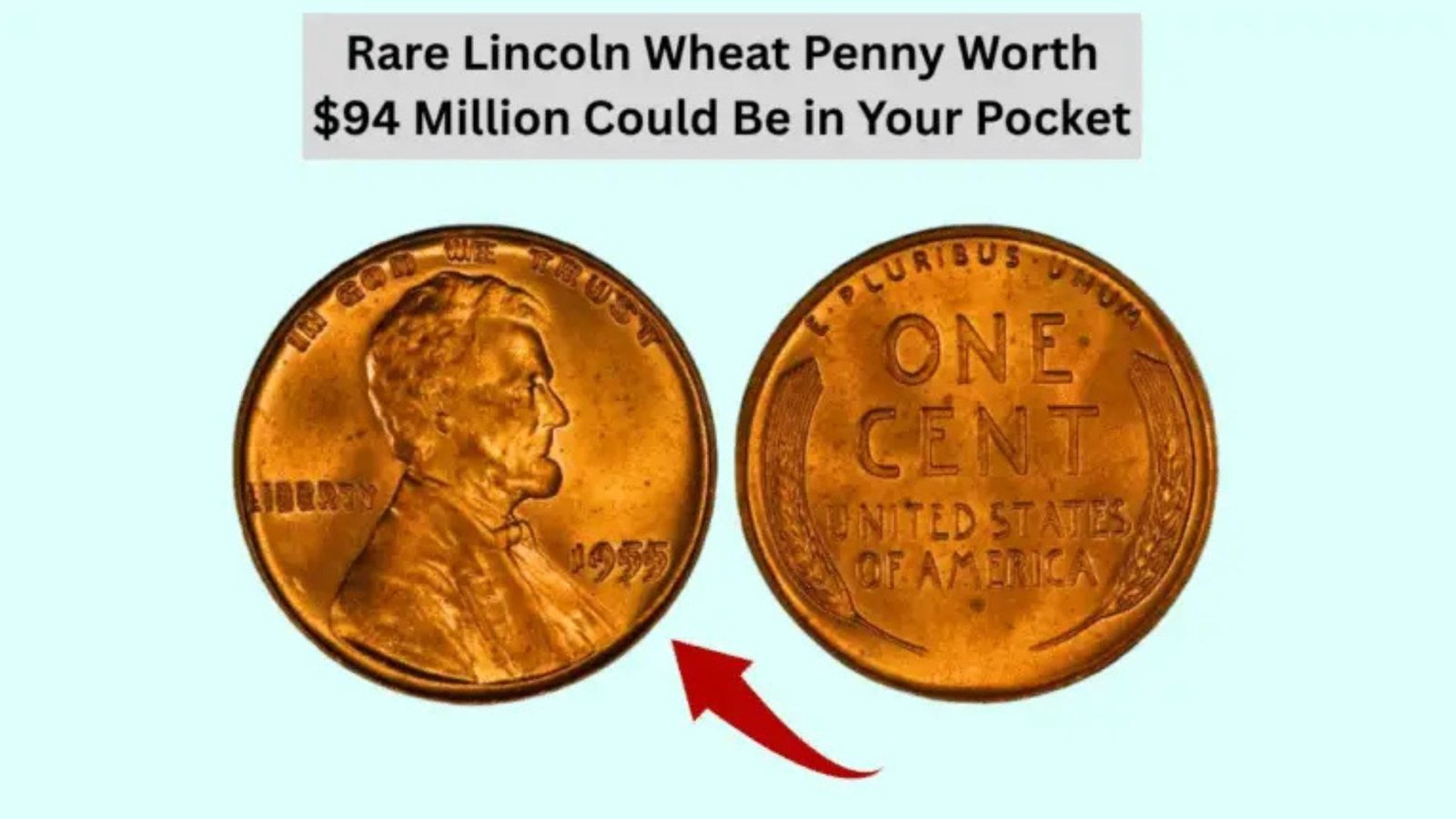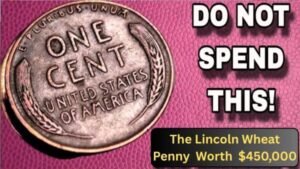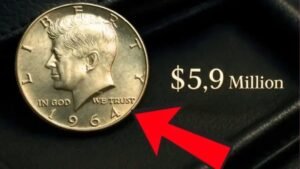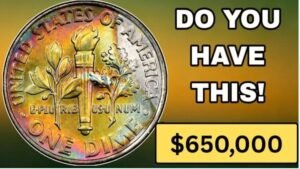Imagine finding a penny in your pocket that’s worth $94 million! The Lincoln Wheat Penny, a small coin minted from 1909 to 1958, has some ultra-rare versions that could turn pocket change into a fortune. One such penny, the 1943 Bronze Lincoln Wheat Penny, is rumored to be valued at $94 million due to a rare minting error, and experts believe a few may still be hiding in circulation. With its iconic Abraham Lincoln portrait and wheat stalk design,
this coin is a collector’s dream. In this article, we’ll explain in simple English what makes this penny so valuable, how to spot it, and why it excites coin enthusiasts. We’ve included a table with tricky terms explained in easy English to help everyone understand. Optimized for SEO, this guide is perfect for anyone hoping to find a life-changing treasure in their spare change.
What is the Lincoln Wheat Penny?
The Lincoln Wheat Penny, often called the “Wheat Cent,” was first minted in 1909 to mark the 100th anniversary of Abraham Lincoln’s birth. Designed by Victor David Brenner, it was the first U.S. coin to feature a president’s portrait. The front, or obverse, shows Lincoln’s profile, while the back, or reverse, has two wheat stalks framing “ONE CENT” and “UNITED STATES OF AMERICA.” Minted until 1958, when it was replaced by the Lincoln Memorial design, these pennies were mostly 95% copper, except in 1943, when wartime shortages led to zinc-coated steel pennies.
The $94 million penny is the 1943 Bronze Lincoln Wheat Penny, a rare error coin accidentally struck in bronze instead of steel at the Denver Mint. Only 15–20 are known to exist, making it one of the rarest coins in the world. Its reddish-brown color and historical significance from World War II drive its value, with one selling for $1.7 million in 2010 and estimates now reaching $94 million due to growing collector demand.
Key Features of the 1943 Bronze Lincoln Wheat Penny
Here’s what makes this rare penny stand out:
| Feature | Description |
|---|---|
| Obverse Design | Abraham Lincoln’s profile, designed by Victor David Brenner. |
| Reverse Design | Two wheat stalks around “ONE CENT” and “UNITED STATES OF AMERICA.” |
| 1943 Bronze Error | Accidentally struck in bronze instead of steel; reddish-brown, not silver-gray. |
| Mint Mark | “D” for Denver Mint, below the 1943 date; no mark means Philadelphia. |
| Material | 95% copper, weighs 3.11 grams (steel pennies are 2.7 grams and magnetic). |
| Rarity | Only 15–20 known to exist, with few in circulation. |
| Value | Up to $94 million estimated; one sold for $1.7 million in 2010. |
Why is the 1943 Bronze Lincoln Wheat Penny So Valuable?
Rare Minting Error
The $94 million valuation stems from a rare minting error during World War II. In 1943, the U.S. Mint switched to zinc-coated steel for pennies to save copper for military supplies like ammunition. However, a few bronze blanks from 1942 were accidentally left in the presses at the Denver Mint, creating the 1943 Bronze Penny. Only 15–20 are known to exist, making it one of the rarest U.S. coins. This mistake, tied to wartime production, makes the coin a collector’s treasure. One sold for $1.7 million in 2010, and its value has soared due to rarity and demand.
Extreme Scarcity
With only a handful of 1943 Bronze Pennies known, their scarcity drives their value. The U.S. Mint produced millions of steel pennies in 1943, but the bronze errors were a fluke. Most were caught, but a few slipped into circulation, making them incredibly hard to find. Collectors, or numismatists, compete fiercely for these coins, pushing auction prices to astronomical levels. The $94 million estimate reflects their rarity and the growing buzz around rare coins in 2025.
Pristine Condition
The condition, or grade, of a coin is critical to its value. A 1943 Bronze Penny in near-perfect condition (graded MS65 or higher by PCGS or NGC) could fetch millions, while a worn one might still be worth thousands. The $94 million coin is likely in Mint State, with no scratches, tarnish, or wear, making it a pristine example. Proper handling is key to preserving its value, as even minor damage can lower its worth.
Historical Significance
The 1943 Bronze Penny is tied to World War II, a time when copper was vital for the war effort. This historical context adds emotional and cultural value, as the coin represents a unique moment in American history. The Lincoln Wheat Penny itself, introduced in 1909, was the first U.S. coin to feature a real person, honoring Abraham Lincoln’s legacy. Its wheat stalk design symbolizes America’s agricultural roots, making it a nostalgic favorite among collectors.
Collector Demand
The numismatic world is buzzing with excitement over rare coins like the 1943 Bronze Penny. Stories of finds, like a teenager discovering one in his lunch money in the 1940s or another found in a bank roll in 1981, keep hope alive. Social media posts on platforms like X amplify the hype, with collectors sharing tips and tales of rare finds. While some claims, like a $94 million valuation, may be speculative, the coin’s confirmed sales (e.g., $1.7 million) prove its worth.
How to Spot a 1943 Bronze Lincoln Wheat Penny
You could have this rare penny in your change! Here’s how to check:
- Check the Date and Mint Mark: Look for a 1943 penny with a “D” mint mark (Denver) below the date. Philadelphia coins (no mint mark) are also rare but less valuable.
- Inspect the Color: Bronze pennies are reddish-brown, unlike the silver-gray steel pennies from 1943. Compare with a regular penny from the 1940s.
- Use a Magnet Test: Steel pennies stick to a magnet due to their iron content; bronze pennies don’t. This is a quick way to spot a potential error.
- Weigh the Coin: A 1943 Bronze Penny weighs about 3.11 grams, while steel pennies are lighter at 2.7 grams. Use a precise scale.
- Look for Authenticity: Beware of fakes. Some steel pennies were coated to look bronze. Check for consistent color and no signs of tampering.
If you find a potential rare coin, preserve its value with these steps:
- Don’t Clean It: Cleaning can scratch the coin and reduce its value.
- Handle Carefully: Use cotton gloves or hold by the edges to avoid fingerprints.
- Get It Graded: Send it to PCGS or NGC for professional grading and authentication.
- Consult Experts: Visit a reputable coin dealer or auction house like Heritage Auctions for an appraisal.
Simple English Explanations for Complex Terms
To make coin collecting easier, here’s a table explaining tricky terms in simple English:
| English Term | Simple English Explanation |
|---|---|
| Numismatics | The hobby of collecting and studying coins and paper money. |
| Minting Error | A mistake made when making a coin, like using the wrong metal. |
| Planchet | The blank metal disc used to make a coin. |
| Obverse | The front side of a coin, usually with a portrait or main design. |
| Reverse | The back side of a coin, often with a secondary design like wheat. |
| Mint Mark | A small letter (like “D” or “S”) showing where the coin was made. |
| Grading | Checking a coin’s condition and giving it a quality score (e.g., MS65). |
Comparison with Other Valuable Lincoln Wheat Pennies
The 1943 Bronze Penny isn’t the only valuable Wheat Penny. Here’s how it compares:
- 1955 Double Die Obverse: Shows doubling on the date and “LIBERTY.” One sold for $456,000 due to its visible error; 20,000–24,000 exist.
- 1909-S VDB: Features designer’s initials; only 484,000 minted. Worth $5,000–$100,000 in high grades.
- 1914-D: Rare Denver issue with 1.2 million minted. Valued at $5,000–$159,000.
- 1922 No D: Missing Denver mint mark. Worth $1,000–$10,000 depending on condition.
The 1943 Bronze Penny’s $94 million estimate surpasses most, though some sources suggest lower values ($1.7–$3.1 million). Its extreme rarity (15–20 known) makes it the most valuable, but the 1955 DDO is more likely to be found in circulation.
Why Collectors Love Lincoln Wheat Pennies
Lincoln Wheat Pennies are beloved for their history, design, and rare errors. The 1943 Bronze Penny’s wartime story—when copper was reserved for bullets—adds intrigue. Collectors, or numismatists, chase these coins for their scarcity and the thrill of finding a mistake that escaped the Mint. Real-life stories, like a Massachusetts teenager finding one in 1958 or a 1981 bank roll discovery, fuel the excitement. Social media posts on X, like one about a $121 million penny, keep the buzz alive, though such high valuations are often unverified. The idea that a penny could be worth millions makes every coin jar a potential treasure chest.
Tips for Finding a 1943 Bronze Lincoln Wheat Penny
You don’t need to be a coin expert to find a valuable penny. Here are practical tips:
- Check Pocket Change: Look at pennies from cash registers, vending machines, or your wallet, especially 1943 coins.
- Buy Bank Rolls: Purchase rolls of pennies from banks, particularly pre-1980 rolls, to inspect for errors.
- Search Old Collections: Check inherited coin jars, piggy banks, or family safes for Wheat Pennies.
- Visit Coin Shows: Attend local coin shows or flea markets to find rare coins from dealers or collectors.
- Use Online Resources: Check NGC Coin Explorer, PCGS CoinFacts, or Reddit’s r/coins for images and tips on spotting errors.
Where to Sell a Valuable Lincoln Wheat Penny
If you find a rare 1943 Bronze Penny, here’s how to sell it for the best price:
- Get It Graded: Professional grading by PCGS or NGC confirms authenticity and boosts value.
- Visit Coin Dealers: Reputable dealers can appraise and offer a fair price or connect you with buyers.
- Use Auction Houses: Platforms like Heritage Auctions or Stack’s Bowers specialize in rare coins and attract high bids.
- Sell Online: List the coin on eBay or GreatCollections, but ensure it’s graded to avoid scams.
Conclusion
The 1943 Bronze Lincoln Wheat Penny, valued at up to $94 million, is a tiny piece of history that could be hiding in your pocket change. This rare coin, accidentally struck in bronze during World War II, is one of the most sought-after in numismatics due to its scarcity, historical significance, and pristine condition. By checking for a 1943 date, reddish-brown color, and using a magnet test, you could uncover a life-changing treasure. Stories of finds in lunch money or bank rolls show that anyone can strike it rich. So, next time you get a penny in change, take a closer look—it might just be worth a fortune.
FAQs
1. What makes the 1943 Bronze Lincoln Wheat Penny so valuable?
Its value comes from a rare minting error where a few pennies were struck in bronze instead of steel in 1943, with only 15–20 known to exist.
2. How do I spot a 1943 Bronze Penny?
Look for a 1943 penny with a “D” mint mark, reddish-brown color, and no magnetic attraction. It should weigh 3.11 grams, not 2.7 grams like steel pennies.
3. Where can I find a 1943 Bronze Penny?
Check pocket change, bank rolls, old coin jars, or coin shows. Flea markets and inherited collections are also good places to look.
4. Are all 1943 pennies valuable?
No, most 1943 pennies are steel and worth a few cents. Only the rare bronze versions are worth millions.
5. What should I do if I find a 1943 Bronze Penny?
Don’t clean it. Store it in a protective sleeve, get it graded by PCGS or NGC, and consult a coin dealer or auction house for appraisal.
6. How does the 1943 Bronze Penny compare to other rare pennies?
It’s rarer than the 1955 Double Die ($456,000) or 1909-S VDB ($100,000), but its $94 million valuation is speculative compared to confirmed sales like $1.7 million.




